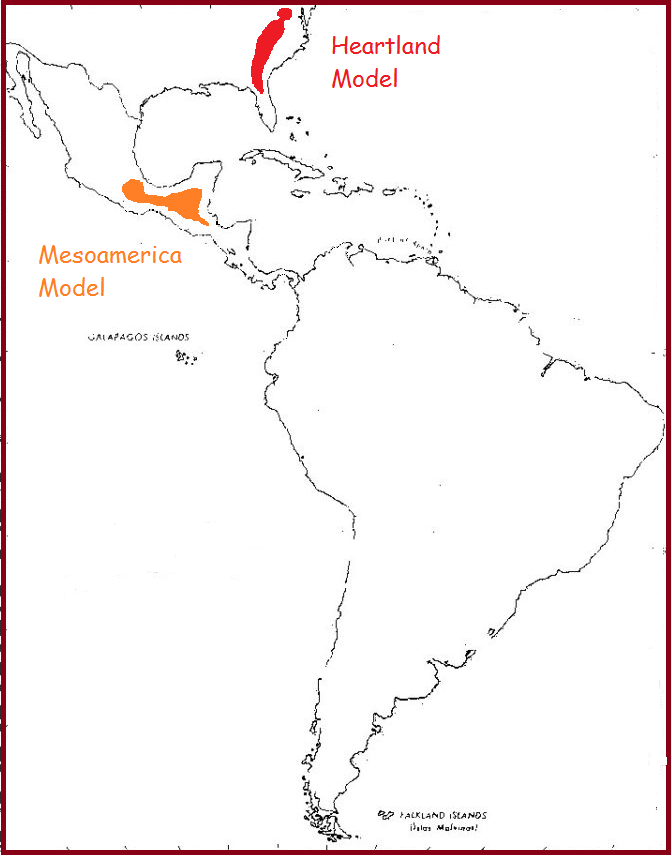
Book of Mormon Geography
As of this writing, there is a serious debate raging among LDS scholars as to the location of the Hill Cumorah, the city of Zarahemla, the Land of Nephi and almost all Book of Mormon geography.The two major theories are the Heartland model and the Mesoamerican model. The Heartland model proposes that Lehi landed in what is now Florida, on the western end. Then the followers of Nephi escaped northward, into what they called the Land of Nephi. The Lamanites soon pushed the Nephites out of the land of Nephi. The Nephites went to Zarahemla, where they found a colony of Jews from Jerusalem. Hemmed in on the east, west and south by Lamanites, the Nephites defended a narrow neck of land leading to the land Northward. This narrow neck is disputed, but one theory holds that Niagara is the Indian word for "narrow neck", and the most likely choice.
The Mesoamerican model has Lehi landing along the coast of Mexico or Guatemala, with the narrow neck of land located at the Isthmus of Tehuantepec. In the Heartland model, the Hopewell Indians, also known as the mound builders, are the Nephites. No archeological evidence has been found that would indicate what the Hopewell Indians called themselves. Their timelime, from non-Mormon sources, matches that of the Book of Mormon almost to the year. The Hopewell are culturally distinct from neighboring tribes, and disappeared completely around 400 AD.
In the Mesoamerican model, the Mayan people are both the Nephites and the Lamanites, but the Mayan state is Lamanite, and actively stretching their empire through war with neighboring tribes/communities. The church at present has no revelation, no statement from the first presidency that would settle the dispute.
The hill in Upstate New York, where Joseph Smith recovered the plates, is known today as the Hill Cumorah, but there is no evidence that it was ever called such by Joseph Smith or anyone else during Joseph's lifetime. The Book of Mormon mentions a hill by that name, where Mormon once hid the records, but the records were recovered and given to Moroni, who left the land of his ancestors before building a stone box and burying the book. The Book of Mormon does not support the theory that it would be buried again at the hill Cumorah. It is also questionable that Moroni would go through the effort of building a stone box in that hill, if a cave was already present containing other records. It is also doubtful that such a cave could exist in the hill in upstate New York, as it consists of loose rock and dirt left over from the action of a glacier.
Joseph Smith may well have known where the true Hill Cumorah was, but never disclosed it publically. According to one account, Joseph took Oliver to the hill, and showed him the records of the Nephites. It has always been assumed that the hill they visited was the same hill where Joseph found the plates, but I have yet to find a definitive statement on the subject that dates to the period in question, nor is there any consensus on whether it was a vision, or whether they actually found a cave.
While crossing the plains with Zion's Camp, Joseph Smith identified a skeleton as the body of Zelph, a white Lamanite who served under a prophet named Omandagus, and who was killed in battle. There are seven separate versions of the account, not one of which was penned by Joseph Smith. Several of those who were present at the scene wrote about the event in their journals, but the diverse accounts wildly disagree on the facts of the encounter. Either Joseph found the remains, or someone else did. Either the fight was with Nephites or it was with other Lamanites. Either Omandagus or Zelph was known from the eastern sea to the rocky mountains. We don't even know for sure when the warrior was killed. Any conclusions drawn from the encounter are tenuous at best.
The Book of Mormon mentions sunken cities, human sacrifice and cannabalism, Sunken cities have been found off the coast of Mexico, but I am not aware of any such cities inside the continental US. Nor do I know of any record or tradition of cannabalism or human sacrifice among the natives of US territories, while both have been established as traditions of the Maya. This adds strong evidence to the Mesoamerican view, in my opinion. Several Book of Mormon prophecies, on the other hand, seem to favor a Heartland model. The dispute is far from settled.
